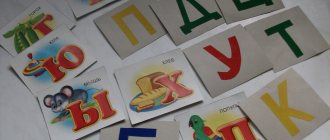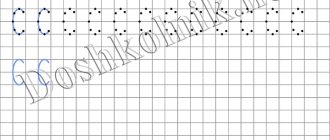The modern Russian alphabet consists of 33 letters, 10 of which are intended to represent vowel sounds and are accordingly called vowels. 21 consonant letters are used to represent consonant sounds. In addition, in modern Russian there are two letters that do not indicate any sounds : ъ (hard sign), ь (soft sign).
All sounds of the Russian language are divided into vowels and consonants.
- Vowel sounds are sounds that are formed with the participation of the voice. There are six of them in Russian: [a], [e], [i], [o], [u], [s] .
- Consonants are sounds that are formed with the participation of voice and noise or noise alone.
Features of consonants
a) Consonant sounds are divided into hard and soft . Most hard and soft consonants form hardness-softness pairs :
[b] - [b′], [c] - [v′], [d] - [g′], [d] - [d′], [z] - [z′], [j] - [ k′], [l] - [l′], [m] - [m′], [n] - [n′], [p] - [p′], [p] - [p′], [ s] - [s′], [t] - [t′], [f] - [f′], [x] - [x′]
(the apostrophe at the top right indicates the softness of the consonant). For example, bow - [bow] and hatch - [l′uk] .
b) Some consonant sounds do not have correlative pairs of hardness-softness, that is, in the language there are unpaired hard consonants [zh], [sh], [ts] (always only hard) and unpaired soft consonants [sh′], [th] , [h] (always only soft ones).
Notes:
- for sounds [й], [ч] it is not customary to indicate softness with an apostrophe, although in some textbooks it is indicated;
- the sound [ш′] is denoted in writing by the letter Ш;
- a line above a sound indicates a doubled (long) sound . In some textbooks, long consonants as follows: [van:a] - bath.
c) Consonant sounds formed with the participation of voice and noise are called voiced (for example, [d], [d′], [z], [z′], etc.); if only noise is involved in the formation of sounds, then such sounds are called voiceless consonants (for example, [t], [t′], [s], [s′], etc.). Most voiced and voiceless consonants in the Russian language form pairs based on voicedness and voicelessness :
[b] - [p], [b′] - [p′], [c] - [f], [v′] - [f′], [g] - [k], [g′] - [ k′], [d] — [t], [d′] — [t′], [z] — [s], [z′] — [s′], [g] — [w] . Compare: beat - drink, year - cat, live - sew.
d) The sounds [th], [l], [l′], [m], |m′], [n], [n′], [р], [р′] do not form a correlative pair with voiceless consonants, therefore, they are unpaired voiced (unpaired voiced consonants are also called sonorant , these are sounds in the formation of which both voice and noise are involved). Conversely, voiceless consonants that do not form a pair with voiced ones are unpaired voiceless . These are the sounds [h], [ts], [x], [x′] .
In a stream of speech, the sound of one sound can be likened to the sound of another sound. This phenomenon is called assimilation . So, in the word life, the sound [z], standing next to the soft [n′], also softens, and we get the sound [z′].
Thus, the pronunciation of the word life is written as follows: [zhyz′n′]. Sound convergence is also possible for sounds that are paired in terms of sonority and deafness. Thus, voiced consonants in positions in front of deaf ones and at the end of a word are similar in sound to paired deaf ones.
Consequently, deafening . For example, a boat is a lo[t]ka, a fairy tale is a jump[s]ka, a cart is a vo[s]. The opposite phenomenon is also possible, when voiceless consonants in a position before voiced ones also become voiced, that is, they become voiced .
For example, mowing is ko[z′]ba, request is pro[z′]ba.
§1. Sound
Sound is the minimum unit of sounding speech. Each word has a sound shell consisting of sounds. The sound corresponds to the meaning of the word. Different words and word forms have different sound patterns. The sounds themselves are not important, but they serve an important role: they help us distinguish between:
- words: [house] - [tom], [tom] - [there], [m'el] - [m'el']
- forms of the word: [house] – [lady´] – [house´ma].
Note:
words written in square brackets are given in transcription.
Indication of softness of consonants in writing
In Russian, the softness of consonants is indicated in the following ways:
- Using the letter ь (soft sign) at the end of a word and in the middle between consonants: benefit - [pol′za], elk - [los′], etc.
Note. The soft sign does not indicate softness of consonants in the following cases:
a) if it serves to separate consonants, the second of which is y (yot): leaves - fox[t′ya], linen - be[l′yo];
b) to distinguish grammatical categories: rye (3 cl., f.r.) - knife (2 cl., m.r.);
c) to distinguish the forms of words (after hissing ones): read (2 liters, singular), cut (imperative form), help (indefinite form of the verb), as well as adverbs: jump up, lay down.
- Through the letters i, e, e, yu, i, indicating the softness of the preceding consonant sound and conveying the vowel sounds [i], [e], [o], [u], [a]: forest - [l′es], honey - [m'ot], lil - [l'il], hatch - [l'uk], crumpled - [m'al].
- Using subsequent soft consonants: cog - [v′in′t′ik], plum - [s′l′iva].
1.5. Speech sounds and letters
Note. For students in grades 1–4, see the topics in the section “Russian Language for Primary School”:
- Russian alphabet, or ABC
- Vowel sounds and letters
- Consonant sounds and letters (+ table of consonant sounds + phrases for easy memorization of voiced and unvoiced sounds)
- Dividing a word into syllables. Accent
1. In accordance with what sounds are indicated by letters, all letters are divided into vowels and consonants .
There are 10 vowel letters:
| A | E | Yo | AND | ABOUT | U | Y | E | YU | I |
There are 21 consonants:
| B | IN | G | D | AND | Z | Y |
| TO | L | M | N | P | R | WITH |
| T | F | X | C | H | Sh | SCH |
2. In the Russian language, not all speech sounds are designated, but only the main ones. There are 42 basic sounds in the Russian language - 6 vowels and 36 consonants, while the number of letters is 33 . The number of basic vowels (10 letters, but 6 sounds) and consonants (21 letters, but 36 sounds) also does not match. The difference in the quantitative composition of basic sounds and letters is determined by the peculiarities of Russian writing.
3. In Russian, hard and soft sounds are indicated by the same letter.
Compare: sir [sir] and ser [s'er].
4. The six basic vowel sounds are represented by ten vowel letters:
[and] - and (darling).
[s] - s (soap).
[a] – a (May) and I (mine).
[o] - o (my) and e (tree).
[e] – e (this) and e (chalk).
[u] – u (bush) and yu (yule).
Thus, to designate the four vowel sounds ([a], [o], [e], [u]) there are two rows of letters: 1) a, o, e, u; 2) I, e, e, yu.
Note!
1) I, e, e, yu are letters, not sounds! Therefore they are never used in transcription. 2) The letters a and i, o and ё, e and e indicate respectively: a and i - the sound [a]; o and e - sound [o], e and e - [e] - only under stress! For the pronunciation of these vowels in an unstressed position, see paragraph 1.8.
5. The letters i, e, ё, yu perform two functions:
- after a consonant they signal that the preceding consonant represents a soft consonant:
I will sit [s'adu], sat down [s'el], sat down [s'ol], here [s'uda];
- after vowels, at the beginning of a word and after the separating ъ and ь, these letters represent two sounds – the consonant [j] and the corresponding vowel:
I - [ja], e - [je], ё - [jo], yu - [jу].
For example:
1. after vowels: chews [zhujot], shave [br'ejut];
2. at the beginning of the word: ate [jél], yak [jak];
3. after the dividing words ъ and ь: ate [сjел], loach [в'jun].
Note!
1) The letters i, e, e after the hissing letters zh and sh do not indicate the softness of the preceding consonant sound. The consonant sounds [zh] and [sh] in the modern Russian literary language are always hard! Shil [shyl], tin [zhes't'], walked [shol].
2) The letter and after the consonants zh, sh and c denotes the sound [s].
Shil [shyl], lived [zhyl], circus [circus].
3) The letters a, y and o in the combinations cha, sha, chu, schu, cho, scho do not indicate the hardness of the consonants ch and sch. The consonant sounds [ch'] and [ш'] in the modern Russian literary language are always soft.
Chum [ch'um], (five) pike [sh'uk], part [ch'as't'], Shchors [Sh'ors].
4) b at the end of a word after a sibilant is not an indicator of softness.
It performs a grammatical function (see paragraph 1.11). 6. The sound [j] is indicated in writing in several ways:
- after vowels and at the end of a word - the letter y;
May [maj].
- at the beginning of a word and between two vowels - using the letters e, e, yu, i, which denote the combination of a consonant [j] and the corresponding vowel;
Ate [jél], yak [jak].
- The presence of the sound [j] is also indicated by the separating ъ and ь – between the consonant and vowels e, ё, yu, ya.
Ate [sjel], loach [v'jun].
7. The letters ъ and ь do not represent any sounds.
- The separating ъ and ь signal that the following e, ё, yu, i designate two sounds, the first of which is [j].
- Non-separating b:
1) indicates the softness of the preceding consonant:
Stranded [m'el'];
2) performs a grammatical function.
For example, in the word mouse ь does not indicate the softness of the preceding consonant, but signals that the given noun is feminine.
For more information about spelling ъ and ь, see paragraph 1.11. Use of b and b.
Exercises for the topic “Speech sounds and letters”
►Read the material on the topic of letters and sounds of the Russian language for students in grades 1-4 in the section “Russian language in PRIMARY SCHOOL”
- Russian alphabet, or ABC
- Vowel sounds and letters
- Consonants and letters
- Dividing a word into syllables. Accent
►Other topics in section 1 “Phonetics. Graphic arts. Spelling"
- 1.1. Speech sounds
- 1.2. Phonetic transcription
- 1.3. Vowels and consonants
- 1.4. Graphic arts. Letters. Alphabet
- 1.5. Speech sounds and letters
- 1.6. Syllable. Word hyphenation rules
- 1.7. Accent
- 1.8. Vowel sounds in stressed and unstressed positions
- 1.9. Spelling of vowels based on their pronunciation
- 1.10. Consonants
- 1.11. Use of letters b and b
- 1.12. Spelling vowels after sibilants
- 1.13. Spelling vowels after C
- 1.14. Changes in consonants in speech
- 1.15. Spelling of voiced/voiceless and unpronounceable consonants
- 1.16. Full phonetic analysis of the word
Sound meaning of letters e, e, yu, i
- The letters e, e, yu, i can represent two sounds : [ye], [yo], [yu], [ya]. This happens in the following cases:
- at the beginning of a word: for example, spruce - [ye]l, hedgehog - [yo]zh, yula - [yu]la, pit - [ya]ma;
- after a vowel sound: washes - mo[ye]t, sings - po[yo]t, give - yes[y]t, bark - la[ya]t;
- after the dividing words ь,ъ: eat - eat [e]m, drink - drink [yot], pour - l[y]t, zealous - ry[ya]ny.
In addition, after the separating ь, two sounds will be denoted by the letter and : nightingales - nightingale[y].
- The letters e, e, yu, i indicate the softness of the preceding consonant in the position after consonants paired in hardness-softness: fur - [m′eh], carried - [n′os], hatch - [l′uk], crumpled - [m′al].
Memo:
- The sounds [th], [l], [m], [n], [r] are voiced (do not have a voiced-voiceless pair)
- The sounds [x], [ts], [ch], [sh′] are voiceless (do not have a voiced-voiceless pair)
- The sounds [zh], [sh], [ts] are always hard.
- The sounds [th], [h], [sh′] are always soft.
§4. Method of formation of consonants
Consonants are sounds, when pronounced, the air encounters an obstacle in its path. There are two types of obstruents in the Russian language: gap and stop - these are the two main ways of forming consonants. The type of obstruction determines the nature of the consonant sound.
A gap is formed, for example, when pronouncing sounds: [s], [z], [sh], [z]. The tip of the tongue only approaches the lower or upper teeth. Frictional consonants can be drawn out: [s-s-s-s], [sh-sh-sh-sh]. As a result, you will clearly hear the noise: when pronouncing [c], it is whistling, and when pronouncing [sh], it is hissing.
The stop, the second type of articulation of consonants, is formed when the speech organs close. The air flow abruptly overcomes this obstacle, the sounds are short and energetic. That's why they are called explosive. You won't be able to pull them. Such, for example, are the sounds [p], [b], [t], [d]. Such articulation is easier to feel and sense.
So, when pronouncing consonants, noise is heard. The presence of noise is a distinctive feature of consonants.
Full phonetic analysis of the word
Phonetic analysis plan:
- Spelling of a word.
- Dividing a word into syllables and stress location.
- Possibility of transfer.
- Phonetic transcription of the word.
- Characteristics of all sounds in order:
- consonant - voiced - voiceless (paired - unpaired), hard - soft (paired - unpaired), which letter is indicated;
- vowel: stressed – unstressed.
- Number of sounds and letters.
- Cases of discrepancy between sound and letter.
Sample parsing
- Buddies
- Syllables: pri-ya-te-li (4 syllables; stress falls on the 2nd syllable).
- Transfer: when-I-those-whether.
- [pr'ijat'l'i]
- p [p] – consonant, voiceless pair, hard pair. р [р'] – consonant, voiced unpaired, soft paired. and [and] – vowel, unstressed. i bracket [j] – consonant, voiced unpaired, soft unpaired. [á] – vowel, stressed. t [t'] – consonant, voiceless pair, soft pair. e [b] – vowel, unstressed. l [l'] – consonant, voiced unpaired, soft paired. and [and] – vowel, unstressed.
- 8 letters – 9 sounds.
- The letter i denotes two sounds – [já].
Thus, speech sounds differ from all other sounds in that they form words. Sound is the smallest basic unit of language, along with words, phrases and sentences. But, unlike them, sound has no semantic meaning.
It is thanks to sounds that we distinguish between the words that we hear and pronounce: house [house] and rum [rum] - the difference is in one sound. Sounds create the sound shell of words and thereby help to distinguish words from each other, i.e. perform a meaning-distinguishing function.
Word and phrase stress, intonation
It is necessary in order to divide the speech stream into separate parts, which ultimately helps the listener to understand what the speaker is saying.
Word stress helps to separate different forms of a word and identical words that differ only with its help.
Functional words and interjections do not have their own stress and, in a phonetic sense, are part of the independent word to which they refer.
Phrase stress allows you to highlight the most important word within one statement. With its help, you can interpret exactly the same phrases in different ways.
As for intonation, it allows you to make sentences declarative, interrogative or exclamatory.
§8. Place of formation of consonants
Consonants differ not only according to the characteristics already known to you:
- deafness-voice,
- hardness-softness,
- method of formation: bow-slit.
The last, fourth sign is important: place of formation . The articulation of some sounds is carried out by the lips, others - by the tongue, its different parts. So, the sounds [p], [p'], [b], [b'], [m], [m'] are labial, [v], [v'], [f], [f' ] – labial-dental, all others – lingual: anterior lingual [t], [t'], [d], [d'], [n], [n'], [s], [s'], [z ], [z'], [w], [zh], [w':], [h'], [ts], [l], [l'], [r], [r'], middle language [ th'] and back-lingual [k], [k'], [g], [g'], [x], [x'].
Distinctive features of vowels
Vowels differ from each other due to the nuances of sound formation. As a rule, this is due to the position and mechanism of operation of the resonator - limited by the shape and size of the physical body in which the air produces resonance.
The largest resonator is the oral cavity, so it is this part of the speech apparatus that greatly influences the quality of sound. The shape of the oral cavity changes in response to changes in the vertical and horizontal position of the tongue.
The lips are responsible for the shape of the hole through which the air stream passes. This also affects the sound and is called labial articulation or labialization (translated from the Latin labri - “lips”).
REFERENCE! Differences between vowels are necessary for them to perform a semantic distinguishing function.
Climb
The rise is determined by the vertical position of the tongue body. He can be:
- upper - the back of the tongue comes closest to the palate. This rise forms closed vowels: [i], [s], [u].
- Middle-upper - the tongue rises to 2/3 of the oral cavity, forming half-open vowels: [e], [o].
- Middle-lower - sounds are pronounced with the lower elevation of the tongue (by 1/3). It corresponds to half-closed vowels.
- Lower - the tongue remains motionless. As a result, open vowels are pronounced: [a]
IMPORTANT! Not all languages recognize all four rises. For example, half-closed vowels are not found in Russian speech.
Row
The vowel series is determined by the horizontal movement of the body of the tongue. Depending on the position it can be:
- anterior - the tongue is as close to the teeth as possible ([i], [e]),
- middle - the tongue occupies a middle position, i.e. remains without movement ([a], [s])
- posterior - the body of the tongue produces sound in the back of the larynx ([u], [o]). Sometimes back vowels are called “dark”.
IMPORTANT! In case of speech defects, anterior articulation [y] and [o] is possible. This occurs if the tip of the tongue is close to the front lower teeth, and the back of the tongue is arched. As a result, in words where hard vowels are pronounced according to the norm, they are softened.
For example: instead of “pol” [pol] - [p'ol], instead of "remote" [pul't] - [p'ul't]. In addition, excessive protrusion of the tongue when pronouncing the sound [e] until it touches the lower lip appears as a case of exaggerated articulation.
Roundness (labialization)
The shape of the resonator - the oral cavity - can also be changed using the lips: by “protruding” them forward (in the form of a tube) or by rounding them. An example of the first method of labialization is the Russian sound [u], the second - [o].
REFERENCE! Together with these vowels, the consonant sounds that precede them are labialized.
It is noticed that only the back vowels are rounded, while the sounds of the front and middle row remain unlabialized.
Nasalization
The Russian language uses articulation through the oral cavity. However, in other languages, nasalization is used - an articulatory technique in which the soft palate (velum) is lowered and air is released through the nasal cavity.
Thus, the nose acts as an additional resonator. Examples of nasalization are common in English and French.
Nasal vowels are opposed to oral vowels (oral, pure, simple), formed with a raised soft palate without the participation of the nasal cavity.
REFERENCE! In the Russian language, nasalization occurs as an articulatory defect - nasality.
Phonation
Phonation is the production of sound using the larynx. Sound quality is determined by the tension and position of the vocal cords.
The mechanism of action can be described as follows: at the exit from the trachea, a stream of air passes through the larynx and the vocal cords located in it. The following development options are possible:
- If they tense and come together, the exhaled air causes vibration. This is how a tone arises, which is required for vowels and voiced consonants.
- Relaxed vocal cords and spread arytenoid cartilages allow air flow to pass without hesitation. As a result, there is no tone, which is typical for the pronunciation of voiceless consonants.
The extreme positions of the vocal cords are called the modal voice (vibration with maximum amplitude) and the laryngeal stop (full reduction).
Usually, free vibration is necessary for the articulation of vocal vowels, however, in the practice of world languages there are cases:
- squeaky voice (Vietnamese),
- voiceless vowels (Japanese).
Tongue root position
The difference in the sound of vowels in some cases is influenced by the position of the root of the tongue:
- pushed forward
- pushed back.
REFERENCE! The contrast between such articulations is not always obvious, except in a number of West African languages (Bambara, Hausa, Yoruba, Djerma, etc.)
Additional articulations
The types of phonations considered do not exhaust the entire variety of possible narrowings in the vocal tract.
For example, in Even, Ket, Tofalar and dialects of the Tuvan language there are vowels formed as a result of narrowing of the pharynx. Such sounds are called pharyngealized. In some cases of pharyngealization, vibration occurs not in the vocal cords, but in the epiglottis.
Erization
The term is derived from the name of the letter k (“er-”) and the suffix “-ization.” In practice, it means adding the suffix er to a word or syllable. This is typical for English and Beijing Chinese. Erization performs a meaning-forming function
When articulating, the technique is expressed in a slight bend of the tip of the tongue back when pronouncing vowels.
"Tension"
Depending on how strong the articulation is, there are:
- "tense" or cardinal vowels,
- "unstressed" vowels. In order to pronounce them, the articulators do not reach the extreme points of position and the sounds remain in the intervals between different rows and rises.
REFERENCE! This quality is not always identified as a phonetic feature; most often it is attributed to a phonological nature.
Longitude
Longitude is a characteristic of sounds that differ in longer or shorter duration relative to each other. In accordance with this feature, short and long vowels are distinguished. Long vowels are indicated using a colon - [aː], [oː], [andː]
In modern Russian, longitude-shortness does not have a meaning-forming meaning, so often a long vowel is perceived as stress or unusual intonation (for example, the exclamation: “Maaaam! It’s blowing me”).
IMPORTANT! A stressed sound is always longer than an unstressed sound. The sound located as the second pre-shock sound, on the contrary, is the shortest.
For example, “Valentine” - contains short [a] and long [and:]
In addition, longitude is characteristic of double sounds, that is, formed by two identical vowels at the junctions of morphemes (surnames, realities, herbariums - [and:] at the end).
The meaningful role of long or short vowels is obvious in the English language. For comparison, here are pairs of words that are different in spelling but almost identical in sound:
- live - leave,
- dock - dork,
- bins - beans,
- ship - sheep
Shva
Sheva (meaning “nothing” in Hebrew) is a vowel sound produced without special articulation. When pronouncing it, the articulators do not make any significant movements and the sound remains neutral. When parsing phonetically, it is indicated by the symbol [ə].
The seam is located in the middle row of the middle rise. It sounds like a cross between [a], [e] and [o].
REFERENCE! As a rule, it is located in an unstressed position, characteristic of the endings of nouns of the 1st declension: “cow” - [ka′rovə], “dog” - [sa′bakə].
Consonants and sounds
Consonant sounds are sounds that create an obstruction in the path of exhaled air.
Voiced consonants are pronounced with the participation of the voice, and voiceless consonants are pronounced without it. The difference is easy to hear in paired consonants, for example, [p] - [b], when pronounced, the lips and tongue are in the same position.
Soft consonants are pronounced with the participation of the middle part of the tongue and are indicated in transcription by an apostrophe ', which occurs when the consonants
- are always soft [th'], [h'], [sh'] ay [ay'] (2 letters, 2 sounds) ray [ray'] (3 letters, 3 sounds) bream [l'esh'] (3 letters, 3 sounds)
- followed before the letters e, e, i, yu, i, b (excl., always hard [zh], [ts], [sh] and in borrowed words) mel [m'el'] (4 letters, 3 sounds) aunt [t'ot'a] (4 letters, 4 sounds) people [l'ud'i] (4 letters, 4 sounds) life [zhyz'n'] (5 letters, 4 sounds) circus [circus] (4 letters, 4 sounds) neck [sheya] (3 letters, 4 sounds) tempo [temp] (4 letters, 4 sounds)
- come before soft consonants (some cases) pancake [bl'in'ch'ik]
Otherwise, consonant sounds will predominantly be hard.
Sibilant consonants include the sounds [zh], [sh], [h'], [sh']. Speech therapists rule their pronunciation penultimately: the tongue must be strong and flexible to resist exhaled air and be held against the roof of the mouth in the shape of a cup. The last ones in line are always the vibrating [p] and [p'].
Diphthongs and Triphthongs
Depending on whether the acoustics of a sound changes during its articulation, there are:
- monophthongs,
- diphthongs,
- triphthongs.
Monophthongs are integral and do not break down into elements. Diphthongs and triphthongs, on the contrary, contain transitions from one sound type to another (and a third).
REFERENCE! In turn, they can be descending (the top of the syllable is the first vowel), ascending (the top of the syllable is the last vowel), and ascending-descending triphthongs occupy an intermediate position.
Russian vowels are predominantly monophthongs. Exceptions are iotated sounds corresponding to the letters i, ё, yu, e. However, if they are paired with consonants, they denote a monophthong and only soften the preceding sound.
For example: “I sing” [poy'u] or “yula” [y'ula], where [y'y] is an ascending diphthong; but in the word “love” [l'ubof'] there is no diphthong.
Thus, vowel sounds are represented in the world's languages in all their diversity. Some of their characteristics are inherent in Russian-language speech, others are expressed only as articulatory defects.
Related posts:
- Rhoticism in speech - complete information Rhotacism (problem with the sound [P]) is the most common disorder in children...
- A child does not know how to say R - we’ll show you how to teach it. To teach a child to pronounce the letter R, you need to regularly perform special...
- What do we know about Morse code? Morse code was created to transmit short information. But use...
- Teaching a child to read Teaching reading in preparation for school. When can you teach a child...
Phonology
Phonology (from the Greek “sound” and “teaching”) is a branch of linguistics devoted to the study of the structure of the sound structure of a language and the functioning of sounds in the language system.
If we take a vowel sound as a phoneme - a unit of language that does not have independent lexical and grammatical meaning - then its functions are obvious:
- act as the core of a syllable, that is, its obligatory element. In some languages, sonants or obstruents take on this role.
- bear emphasis, that is, highlight words within a word;
- determine tone, that is, use pitch to differentiate meaning within words or morphemes.
Vowel sounds
People often make mistakes when writing vowels in a word, using the principle “what I hear is what I write.” For others, on the contrary, it seems that there may be a catch in the word, and in place of the audible A there should definitely be an O. In most cases, the letter can be checked in a simple way.
Main types
Regular and iotated, stressed and unstressed are options for the groups into which vowel sounds are divided. If the first of the first group (A, I, O, U, Y, E) have one sound each, then the second (E, E, Yu, Ya) have two: YE, YO, YU, YA. Double sound appears in the following cases:
- the letter comes after another vowel (unclear, hiring, moving, interpreting);
- the letter comes after b or b (sommelier, beast, pour, pig);
- the letter is at the beginning of the word (European, capacious, yurt, barley).
The letter I can also become iotated when it comes after a soft sign (boyish, frogish, weasel).
Another group is stressed and unstressed sounds. To determine the stressed letter, listen to which syllable becomes “upper,” that is, which is highlighted by intonation when pronouncing a word. There are as many vowels in a word as there are syllables, and this rule works vice versa. The breakdown when hyphenating a word does not always coincide with the way words are divided into syllables, so you need to be careful when parsing phonetically.
Verification method
Vowels are clearly heard if they are stressed. In a position called unstressed, some vowels may differ, for example, in the word “pinch” the vowel I sounds like E. To determine which letter needs to be placed, test words are used. For the word “pinch” the test word is “pinch”. In the stressed position, the letter is heard clearly. Examples: tremble - trembling, pink - pink, humble - humble. In some cases there is no test word, as in the words “vinaigrette”, “February”. These words need to be remembered.
Stressed and unstressed vowels
The vowels in a word are pronounced differently. Only one vowel is always emphasized by the voice and sounds longer than the other vowel sounds, for example in the word:
dog
In the second syllable, the vowel sound indicated by the letter “a” sounds with particular strength and duration.
It is in a strong position and sounds clear and crisp. This vowel sound is stressed.
Let's observe:
- peaceful
- city
- smile
- drawing
In Russian, the strong position for vowels is the stressed position.
The remaining vowel sounds are in a weak position without stress. They sound less clear and are subject to changes during pronunciation. Such sounds in a weak position are called unstressed vowels. To correctly write a word with an unstressed vowel, you will need a test word for it.
Publicity of sounds
Vowels are a type of sound during which the air flow through the larynx or nasal cavity is unobstructed. The vocal cords are vibrated by an air stream. At this moment they are tense and shifted.
REFERENCE! Vowels are sometimes called “mouth openers” because they require you to open your mouth wide to pronounce them louder. This distinguishes them from consonants - “mouth-closers”, because in order to make them louder, you need to bring the organs of the mouth as close as possible.
Vowel differentiation is achieved by changing the shape of the resonator. This could be a change in body position or the root of the tongue or lips. In the languages of the world, nasal articulation and phonation are also possible.





